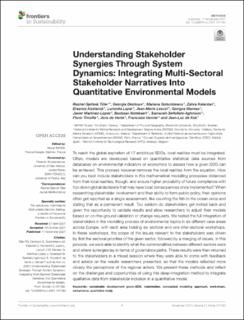| dc.contributor.author | Tiller, Rachel | |
| dc.contributor.author | Destouni, Georgia | |
| dc.contributor.author | Golumbeanu, Mariana | |
| dc.contributor.author | Kalantari, Zahra | |
| dc.contributor.author | Kastanidi, Erasmia | |
| dc.contributor.author | Lazar, Luminita | |
| dc.contributor.author | Lescot, Jean-Marie | |
| dc.contributor.author | Maneas, Giorgos | |
| dc.contributor.author | Martínez-López, Javier | |
| dc.contributor.author | Bastiaan, Notebaert | |
| dc.contributor.author | Seifollahi-Aghmiuni, Samaneh | |
| dc.contributor.author | Timofte, Florin | |
| dc.contributor.author | Vente, Joris de | |
| dc.contributor.author | Vernier, Francoise | |
| dc.contributor.author | de Kok, Jean-Luc | |
| dc.date.accessioned | 2022-03-22T13:47:18Z | |
| dc.date.available | 2022-03-22T13:47:18Z | |
| dc.date.created | 2022-01-12T16:16:31Z | |
| dc.date.issued | 2021 | |
| dc.identifier.citation | Frontiers in Sustainability. 2021, 2 1-12. | en_US |
| dc.identifier.issn | 2673-4524 | |
| dc.identifier.uri | https://hdl.handle.net/11250/2986854 | |
| dc.description.abstract | To reach the global aspiration of 17 ambitious SDGs, local realities must be integrated. Often, models are developed based on quantitative statistical data sources from databases on environmental indicators or economics to assess how a given SDG can be achieved. This process however removes the local realities from the equation. How can you best include stakeholders in this mathematical modelling processes distanced from their local realities, though, and ensure higher probability of future compliance with top-down global decisions that may have local consequences once implemented? When researching stakeholder involvement and their ability to form public policy, their opinions often get reported as a single assessment, like counting the fish in the ocean once and stating that as a permanent result. Too seldom do stakeholders get invited back and given the opportunity to validate results and allow researchers to adjust their models based on on-the-ground validation or change requests. We tested the full integration of stakeholders in the modelling process of environmental topics in six different case areas across Europe, with each area holding six sectoral and one inter-sectoral workshops. In these workshops, the scope of the issues relevant to the stakeholders was driven by first the sectoral priorities of the given sector, followed by a merging of issues. In this process, we were able to identify what the commonalities between different sectors were and where synergies lay in terms of governance paths. These results were then returned to the stakeholders in a mixed session where they were able to come with feedback and advice on the results researchers presented, so that the models reflected more closely the perceptions of the regional actors. We present these methods and reflect on the challenges and opportunities of using this deep-integration method to integrate qualitative data from stakeholder inclusion in a quantitative model. | en_US |
| dc.language.iso | eng | en_US |
| dc.publisher | Frontiers | en_US |
| dc.relation.uri | https://www.frontiersin.org/articles/10.3389/frsus.2021.701180/full | |
| dc.rights | Navngivelse 4.0 Internasjonal | * |
| dc.rights.uri | http://creativecommons.org/licenses/by/4.0/deed.no | * |
| dc.subject | qualitative study | en_US |
| dc.subject | compliance | en_US |
| dc.subject | conceptual modeling approach | en_US |
| dc.subject | workshops | en_US |
| dc.subject | stakeholder | en_US |
| dc.subject | sustainable development goals | en_US |
| dc.subject | SDG | en_US |
| dc.title | Understanding Stakeholder Synergies Through System Dynamics: Integrating Multi-Sectoral Stakeholder Narratives Into Quantitative Environmental Models | en_US |
| dc.type | Peer reviewed | en_US |
| dc.type | Journal article | en_US |
| dc.description.version | publishedVersion | en_US |
| dc.rights.holder | Copyright © 2021 Tiller, Destouni, Golumbeanu, Kalantari, Kastanidi, Lazar, Lescot, Maneas, Martínez-López, Notebaert, Seifollahi-Aghmiuni, Timofte, de Vente, Vernier and de Kok. This is an open-access article distributed under the terms of the Creative Commons Attribution License (CC BY). The use, distribution or reproduction in other forums is permitted, provided the original author(s) and the copyright owner(s) are credited and that the original publication in this journal is cited, in accordance with accepted academic practice. No use, distribution or reproduction is permitted which does not comply with these terms. | en_US |
| dc.source.pagenumber | 1-12 | en_US |
| dc.source.volume | 2 | en_US |
| dc.source.journal | Frontiers in Sustainability | en_US |
| dc.identifier.doi | 10.3389/frsus.2021.701180 | |
| dc.identifier.cristin | 1979776 | |
| dc.relation.project | EC/H2020/773782 | en_US |
| cristin.ispublished | true | |
| cristin.fulltext | original | |
| cristin.qualitycode | 1 | |

